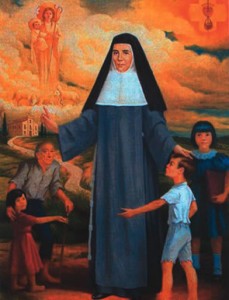July Saints
 Blessed Maria Ana Mogas Fontcuberta (1827-1886)
Blessed Maria Ana Mogas Fontcuberta (1827-1886)
Maria Ana Mogas Fontcuberta was born in Grenollers, Spain, on 13 January 1827 to a devout Christian family. As her parents both died when she was young, Maria Ana was raised by a devout aunt who instilled the faith and the practice of virtue into her daily life.
At the age of 21, she felt called to follow Jesus. In Barcelona, she met Father Jose Toler, an exclaustrated Capuchin, who had been given permission to minister to people in the world. Under his direction were two exclaustrated Capuchin nuns who asked Maria Ana to assist them in founding a new congregation dedicated to the education of children. The nuns had recognised that Maria Ana had much to offer their project and she in turn was deeply impressed by the Franciscan humility and simplicity of these religious women.
With the approval of Bishop Casadevall of Vic, the Congregation of the Capuchins of the Divine Shepherdess was formed in 1850, and the new community took over a school in Ripoli. Despite opposition and many economic difficulties, the nuns sought to live a rigorously monastic life. Soon it was found necessary that one of them be entrusted with the direction of the community, and Maria Ana was elected to take up the reins, demonstrating a markedly Franciscan and deeply Marian spirit befitting this new charism in the Church. The two exclaustrated nuns returned to their original community shortly afterwards.
Maria Ana had to be certified in order to take over the school and she passed her exams brilliantly. The Lord enriched the institute with new members, who were given their initial formation by the co-foundress herself, and new houses were established.
In 1865 she was asked by Bishop Serra to found an institution for the rehabilitation of young prostitutes in Ciempozuelos. However, after facing many difficulties, Maria Ana had to abandon this project and accepted instead the direction of a school in Madrid. The distance between Barcelona and Madrid and the lack of communication eventually led to a division between the two communities, with Mother Maria Ana remaining in Madrid. Her generosity in responding to the needs of God’s children bore abundant fruit and she died on 3 July, 1886. Pope John Paul II said of her: “…she forged, in union with the tabernacle and the cross, a spirituality inspired by the Heart of Christ.”
Blessed Maria Ana, obtain for us the spirit of perseverance in doing good.
(Source: Internet – various)
 Saint Bonaventure (1221-1274)
Saint Bonaventure (1221-1274)
St. Bonaventure, known as “the seraphic doctor,” was born at Bagnorea in Tuscany, in 1221. At the age of twenty-two, he entered the Franciscan Order. Having made his vows, he was sent to Paris to complete his studies.
At the age of thirty-five he was chosen General of his Order and restored a perfect calm where peace had been disturbed by internal dissensions. He was nominated to, but refused, the archbishopric of York; in 1273, however, he was created Cardinal Bishop of Albano.
He was the greatest mystical theologian and among the greatest scholastics of the Middle Ages. He wrote sermons and commentaries on holy scripture and laboured for unity among the friars of his order.
Before his death he abdicated his office of General of the Franciscan Order. He died while he was assisting at the Second Council of Lyons, on July 15, 1274.
Saint Bonaventure, teach us to appreciate our faith.
(Source: A New Dictionary of the Saints, Donald Attwater. 1993 Burns & Oates, Kent)
 Saint Peter Chrysologus (406-450)
Saint Peter Chrysologus (406-450)
Born in Imola, Peter Chrysologus studied in his native city and was named bishop of Ravenna in 433. Known for his personal sanctity and his remarkable skills in oratory, he was much esteemed by the then Emperor Leo I. He practised many corporal and spiritual works of mercy, and ruled his flock with utmost diligence and care.
He was called ‘Chrysologus’ (golden-worded) for his achievements as a preacher. He worked to eradicate paganism in his diocese and counselled the heretic Eutyches, urging him to return to obedience to the Holy See.
He died at Imola, Italy in 450 and in 1729 was made a Doctor of the Church, largely as a result of his simple, practical, and clear sermons which have come down to us, nearly all dealing with Gospel subjects.
Saint Peter, show us how to resist the influence of secularism in our society.
(Encyclopedia of the Saints, Matthew, Margaret & Stephen Bunson.1998 Our Sunday Visitor Publishing, Indiana)

 Entries(RSS)
Entries(RSS)